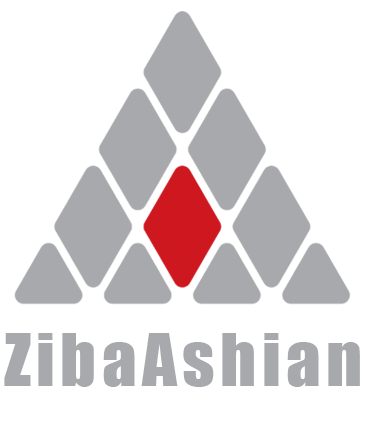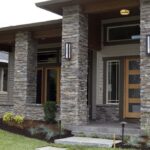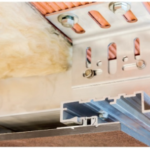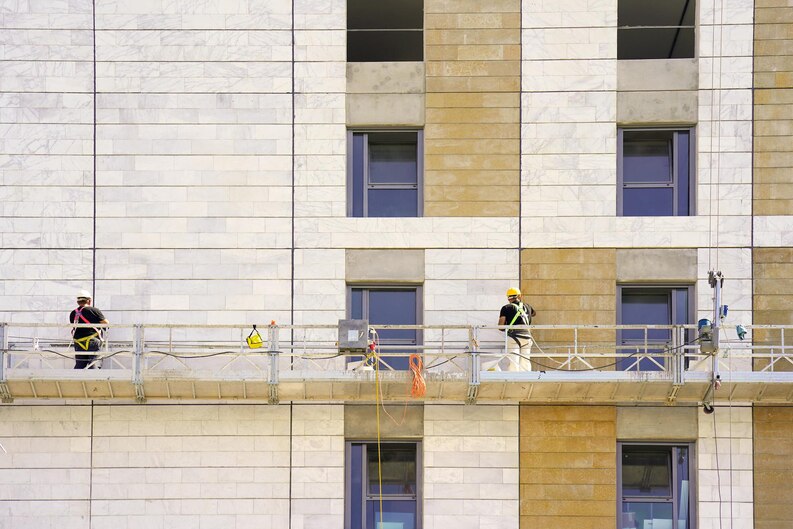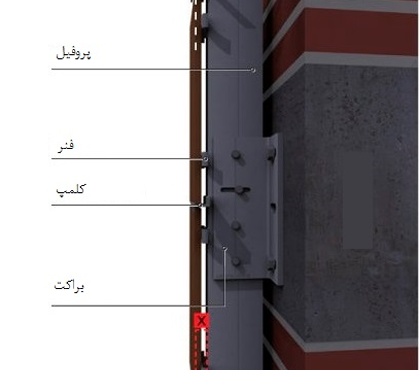What is a dry facade
Dry facade is a modern and efficient method for attaching cladding to buildings. In this system, mechanical fasteners are used, eliminating the need for mortar. One of the key features of dry facade is that the materials forming the cladding are spaced at a distance from the main wall, creating an air gap between them.
This cladding consists of several layers The outer layer creates an attractive and durable facade, enhancing the building’s beauty The interior space is responsible for providing proper ventilation within the building. An insulating layer is added to this layer to prevent heat loss. The final inner wall, which completes the building and also contributes to providing a suitable indoor environment. All of these layers are connected to the main structure of the building using steel and aluminum structures. This method not only enhances the building’s efficiency but also ensures the beauty and strength of the facade.

What is the difference between a dry facade and a conventional facade?
Dry facade is a modern approach to attaching cladding to buildings, which has a significant difference from conventional (mortar) facades. In conventional facades, mortar is used to attach cladding materials to the building’s structure. However, in dry facades, mortar is eliminated, and the surface of the facade, including materials such as ceramics, stone, cement board, HPL, and similar materials, is primarily attached to the building’s structure using mechanical fasteners.
The main difference between these two, conventional facades and dry facades, lies in the method of attaching materials to the structure. Dry facade, as an advanced and efficient method, utilizes faster and more effective executions for attaching cladding to buildings. In addition to efficiency, it also adds value to the beauty and strength of the facade.
The necessity and importance of using dry facades.
In today’s world, the development of a variety of products for use in building facades and the preference of designers for innovative materials in facade execution have significantly increased the need for the use of dry facade attachments in building facades. This increased demand for dry facade installation has provided us with the opportunity to use innovative building materials with various designs, textures, and colors.
For example, specific features such as very low water absorption in porcelain ceramics (less than 0.5%) minimize the adherence of cement mortar to them, making it impossible to use porcelain ceramics in traditional mortar methods for facades. This issue applies to building materials and other innovative surfaces such as HPL, Corian, and thermowood.
The use of dry facades not only enhances the diversity and beauty of facades but also facilitates the incorporation of innovative materials in construction projects. This method not only offers a faster execution but also provides superior advantages such as reducing material wastage and enhancing building efficiency.
Reasons and Benefits of Choosing
The use of dry facades for building cladding offers numerous advantages, which will be discussed below:
- Protection Against Weather Elements: This installation system, by creating a separate exterior skin for the building, performs excellently against weather elements such as rain, sun, and wind. This cladding preserves the building and prevents surface damage and wear.
- Ventilation within Building Walls: Dry facades allow for better ventilation within the building walls and aid in moisture removal from the wall’s surface. This feature contributes to the preservation of the health of the walls and prevents issues related to moisture.
- Thermal Insulation Efficiency: Dry facades significantly enhance thermal insulation performance. This is due to the separation of the facade from the building wall, which prevents direct sunlight and raindrops from impacting the wall. This action also leads to a reduction in heat loss from the building.
- Temperature Balance Preservation: Dry facades allow for temperature balance preservation on the building wall’s surface and prevent the creation of thermal bridges and insulation discontinuities around columns and beams. This is crucial for enhancing the thermal insulation performance of the walls.
- Cracks in the Facade: Dry facades allow for the creation of various cracks, indentations, and projections on the facade that are not easily achievable using mortar methods. This possibility allows designers to create unique and beautiful facades.
- Eliminating Irregularities: In the case of using mortar for facade construction, if the walls are irregular, it may require excessive leveling of the wall, leading to increased mortar consumption. However, with dry facades, irregularities can be easily covered, reducing mortar consumption.
- Easy Replacement of Tiles: Dry facades provide the possibility of quick and easy replacement of tiles. It is possible to open a section of the facade and reinstall the tiles, and in some cases, even relocate the entire building’s facade to a different location.
Types of Dry Facades
The types of dry facades are divided based on the main differences in how the connections are placed in them. These types include:
- Visible Dry Facade: In this type of facade, a portion of the brackets used to support the ceramic or cladding materials is visible from the outside. These facades are beautiful and attractive, especially when they make use of the visible elements in their designs.
- Invisible Dry Facade: In this type of facade, the brackets and connections are designed in a way that they are not easily visible from the outside. These facades are known for their simple and beautiful designs, and the invisible connections enhance the aesthetics of the facade.
Each of these facade types has its own features and advantages, and depending on the design requirements and preferences, one can be used in building projects.
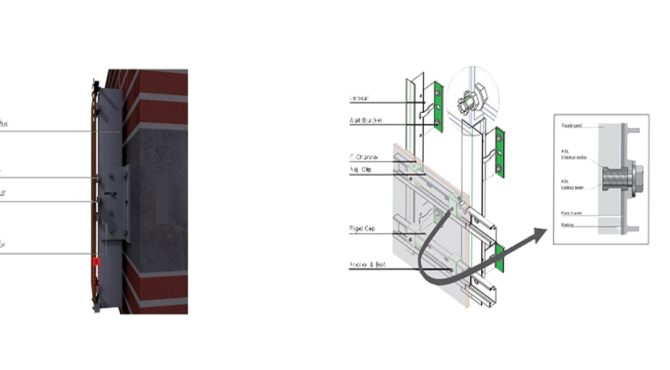 Installation Systems for Dry Facades
Installation Systems for Dry FacadesTypes of Materials Installable with Dry Facade Method
With the dry facade method, a variety of materials can be installed on the building walls. These materials can include the following:
-
- Ceramics: Ceramics are common materials for this installation system. They are available in various dimensions and designs, and are among the popular choices for exterior facades.
- Natural Stone: Natural stones such as granite, marble, and other types of stones can be used for dry facades. They create high-quality facades with beautiful designs and resistance to weather elements.
- Cement Board and Composites: Materials such as cement board and composites are also suitable for dry facades. They have high resistance and durability and can support various designs.
- HPL (High-Pressure Laminate): HPL materials are used as a water and heat-resistant option for dry facades. These materials, with a variety of colors and designs, are suitable for both interior and exterior facades.
- Thermowood: Thermowood is a natural material that is heat-treated to enhance its resistance to moisture and temperature fluctuations. These materials are suitable for facades.
- Other Innovative Materials: Additionally, innovative materials such as fiber cement and various composites are also suitable for dry facades.
-
- Depending on the type of materials, the structural strength of the building, and design requirements, the choice of the appropriate facade type can be helpful.
Influential Parameters on Price
The cost of implementing this system is influenced by various factors. The most important parameters that affect the cost of dry facades include:
-
-
- The price of cladding materials: The choice of cladding materials, including ceramics, stone, HPL, and other materials, directly determines the cost. The price and type of materials can make significant differences in the cost.
- The type of installation system: The type of installation system also has an impact. Visible or Invisible dry facades may come with significant cost differences. Additionally, using different dry facade systems can have an impact.
- The type of building structure: The type of building on which the facade is installed also matters. The dimensions, shape, and structural details of the building determine the amount of materials and substructure required.
- The dimensions of cladding materials and cutting: The dimensions and the need for cutting cladding materials can increase costs. Larger dimensions of materials may require fewer of them, potentially reducing substructure costs.
- The architectural shape and building volume: The architectural design and shape of the building have a significant impact on the price. The presence of irregularities or protrusions on the facade surface may increase costs.
- The height of the building: The height of the building also has a significant impact on the cost. Taller buildings require more infrastructure and the installation of facades at higher elevations, which increases the cost.
- The geographical location of the project: The geographical location of the project also affects the cost. Transportation costs for materials and labor vary in different regions.
-
As a result, a detailed analysis of these parameters and the specific settings of each project can help optimize the construction costs.
